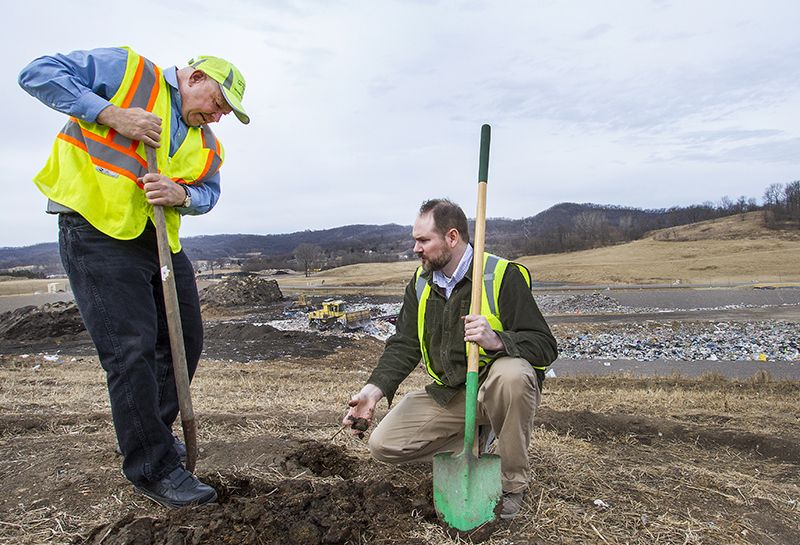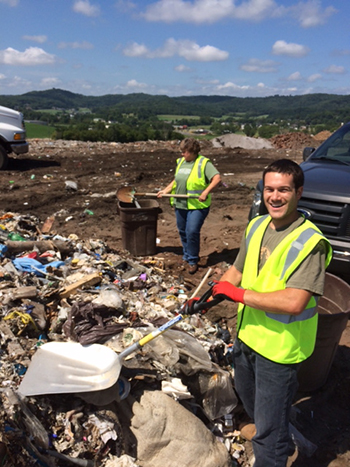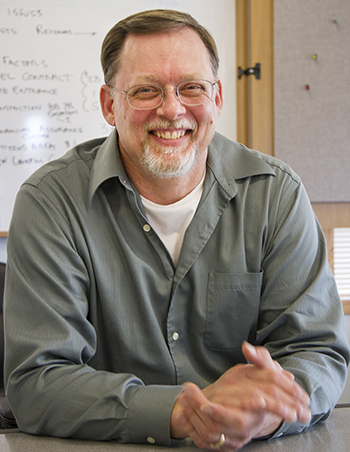Posted 11:31 a.m. Wednesday, March 18, 2015

UW-L Geography and Earth Science faculty member Paul Reyerson is considering developing a long-term partnership with the landfill to do soil-related research at the site. UW-L graduate student Dan Liska is studying how ash could be used to potentially increase the breakdown of waste.
 UW-L Assistant professor Paul Reyerson, right, is considering developing a long-term partnership with the La Crosse County Landfill to help the landfill restore quality topsoil while providing research and learning opportunities to UW-L students. Here Reyerson takes a close look at the topsoil with Hank Koch, director of solid waste department for La Crosse County.[/caption]
UW-L Assistant Professor Paul Reyerson stood on a patch of packed soil at the La Crosse County Landfill.
“This is not good,” he said pointing to the earth below his feet.
The topsoil was too compact. A less dense soil — with worms and ants to create holes, decayed plant matter and room for water to absorb invites plant growth and less erosion.
Reyerson, a faculty member in UW-L’s Geography and Earth Science Department, is considering developing a long-term partnership with the landfill to do soil-related research at the site. He is one of many UW-L faculty members and students in the process or already pursuing research to restore and improve the landfill.
“Frankly, I find this all fascinating,” said Reyerson looking at the early spring brown grass slopes and fields of dark dirt. “I see so much more here than garbage. There is chemistry, physics and ecology…”
Having a connection with the university is important for the landfill’s future, explains Hank Koch, director of solid waste department for La Crosse County. Landfill staff are eager to form more partnerships with UW-La Crosse experts and students who can help with any aspect of restoring the landfill to the natural prairie and oak savanna that once flourished there as well as improving waste management practices.
The landfill is already a “living laboratory” for several UW-L projects.
“To tap into the knowledge of UW-L faculty and have students on board who bring all of that energy is wonderful,” says Koch.
[caption id="attachment_39655" align="alignright" width="350"]
UW-L Assistant professor Paul Reyerson, right, is considering developing a long-term partnership with the La Crosse County Landfill to help the landfill restore quality topsoil while providing research and learning opportunities to UW-L students. Here Reyerson takes a close look at the topsoil with Hank Koch, director of solid waste department for La Crosse County.[/caption]
UW-L Assistant Professor Paul Reyerson stood on a patch of packed soil at the La Crosse County Landfill.
“This is not good,” he said pointing to the earth below his feet.
The topsoil was too compact. A less dense soil — with worms and ants to create holes, decayed plant matter and room for water to absorb invites plant growth and less erosion.
Reyerson, a faculty member in UW-L’s Geography and Earth Science Department, is considering developing a long-term partnership with the landfill to do soil-related research at the site. He is one of many UW-L faculty members and students in the process or already pursuing research to restore and improve the landfill.
“Frankly, I find this all fascinating,” said Reyerson looking at the early spring brown grass slopes and fields of dark dirt. “I see so much more here than garbage. There is chemistry, physics and ecology…”
Having a connection with the university is important for the landfill’s future, explains Hank Koch, director of solid waste department for La Crosse County. Landfill staff are eager to form more partnerships with UW-La Crosse experts and students who can help with any aspect of restoring the landfill to the natural prairie and oak savanna that once flourished there as well as improving waste management practices.
The landfill is already a “living laboratory” for several UW-L projects.
“To tap into the knowledge of UW-L faculty and have students on board who bring all of that energy is wonderful,” says Koch.
[caption id="attachment_39655" align="alignright" width="350"] Dan Liska, UW-L graduate student in microbiology, collecting samples at the La Crosse County Landfill for his research. He is pictured with Bonnie Bratina, UW-L microbiology professor.[/caption]
This spring UW-L graduate student Dan Liska is studying how ash from Xcel Energy could potentially increase the breakdown of the waste in the landfill to create more space. The results will contribute to his thesis in microbiology. Liska, who describes himself as passionate about environmental sustainability, developed the partnership after meeting with Koch and his UW-L adviser to discuss projects that would improve waste disposal and the environment. The project is still in its infancy, but Liska says other studies have shown that ash mixed with waste leads to higher breakdown.
“I am inspired by the landfill’s dedication to improve the community and the environment,” says Liska. “It can be too easy to forget about where our trash goes after taking it out to the street.”
UW-L geography major Shelby Jacobson just completed a study on La Crosse and Onalaska’s new, single stream recycling program to find it increased recycling in the cities by 137 percent over the previous year. Also, a survey she distributed found the majority of citizens found single stream recycling to be simple and convenient.
Jacobsen says the research she has done prepares her for her future career. “I would like to go into sustainability after graduation, and studying how recycling tonnage increased after a single year is important in making communities more sustainable,” she says.
Others are exploring opportunities. UW-L Assistant Professor of Biology Barrett Klein hopes to put honeybee hives on the property to study bee sleep behavior and learning.
Landfill staff are open to any suggestions for future research, says Nick Nichols, sustainability coordinator for La Crosse County.
Potential examples could be studying invasive species, restoration of the natural habitat, air quality improvement, waste reduction and diversion, landfill management processes, bird control and more.
“We don’t just want to be a landfill. We want to be the best landfill we can,” explains Koch.
Reyerson envisions a future where he could advise UW-L student interns who measure soil density, organic matter and test soil pH and other factors that ultimately influence the landfill environment. While learning, these students would be able to network with professionals and learn field skills such as soil sampling and measuring, which are valuable for future careers in conservation and natural resources management. For Reyerson, the landfill collaboration would broaden his resume, open up new research avenues and provide opportunities for community service.
[caption id="attachment_39647" align="alignleft" width="350"]
Dan Liska, UW-L graduate student in microbiology, collecting samples at the La Crosse County Landfill for his research. He is pictured with Bonnie Bratina, UW-L microbiology professor.[/caption]
This spring UW-L graduate student Dan Liska is studying how ash from Xcel Energy could potentially increase the breakdown of the waste in the landfill to create more space. The results will contribute to his thesis in microbiology. Liska, who describes himself as passionate about environmental sustainability, developed the partnership after meeting with Koch and his UW-L adviser to discuss projects that would improve waste disposal and the environment. The project is still in its infancy, but Liska says other studies have shown that ash mixed with waste leads to higher breakdown.
“I am inspired by the landfill’s dedication to improve the community and the environment,” says Liska. “It can be too easy to forget about where our trash goes after taking it out to the street.”
UW-L geography major Shelby Jacobson just completed a study on La Crosse and Onalaska’s new, single stream recycling program to find it increased recycling in the cities by 137 percent over the previous year. Also, a survey she distributed found the majority of citizens found single stream recycling to be simple and convenient.
Jacobsen says the research she has done prepares her for her future career. “I would like to go into sustainability after graduation, and studying how recycling tonnage increased after a single year is important in making communities more sustainable,” she says.
Others are exploring opportunities. UW-L Assistant Professor of Biology Barrett Klein hopes to put honeybee hives on the property to study bee sleep behavior and learning.
Landfill staff are open to any suggestions for future research, says Nick Nichols, sustainability coordinator for La Crosse County.
Potential examples could be studying invasive species, restoration of the natural habitat, air quality improvement, waste reduction and diversion, landfill management processes, bird control and more.
“We don’t just want to be a landfill. We want to be the best landfill we can,” explains Koch.
Reyerson envisions a future where he could advise UW-L student interns who measure soil density, organic matter and test soil pH and other factors that ultimately influence the landfill environment. While learning, these students would be able to network with professionals and learn field skills such as soil sampling and measuring, which are valuable for future careers in conservation and natural resources management. For Reyerson, the landfill collaboration would broaden his resume, open up new research avenues and provide opportunities for community service.
[caption id="attachment_39647" align="alignleft" width="350"] Nick Nichols, sustainability coordinator for La Crosse County[/caption]
That community service translates to a long-term community benefit. As Nichols walks the site he points to a newly constructed pedestrian bridge and the beginnings of biking and hiking trails that the landfill plans to expand into 7-10 miles of trails through prairie and forests that encompass the 350-acre site. Making land once opened to hold garbage, useful to for public recreation is long-term project in its infancy, he adds. The landfill won’t be closed for dumping for 50 years.
“This is a public property,” says Nichols. “Once the site closes, it will be turned back over to the public. Instead of waiting until the end to begin the restoration process — we’d like to do it now.”
Nick Nichols, sustainability coordinator for La Crosse County[/caption]
That community service translates to a long-term community benefit. As Nichols walks the site he points to a newly constructed pedestrian bridge and the beginnings of biking and hiking trails that the landfill plans to expand into 7-10 miles of trails through prairie and forests that encompass the 350-acre site. Making land once opened to hold garbage, useful to for public recreation is long-term project in its infancy, he adds. The landfill won’t be closed for dumping for 50 years.
“This is a public property,” says Nichols. “Once the site closes, it will be turned back over to the public. Instead of waiting until the end to begin the restoration process — we’d like to do it now.”